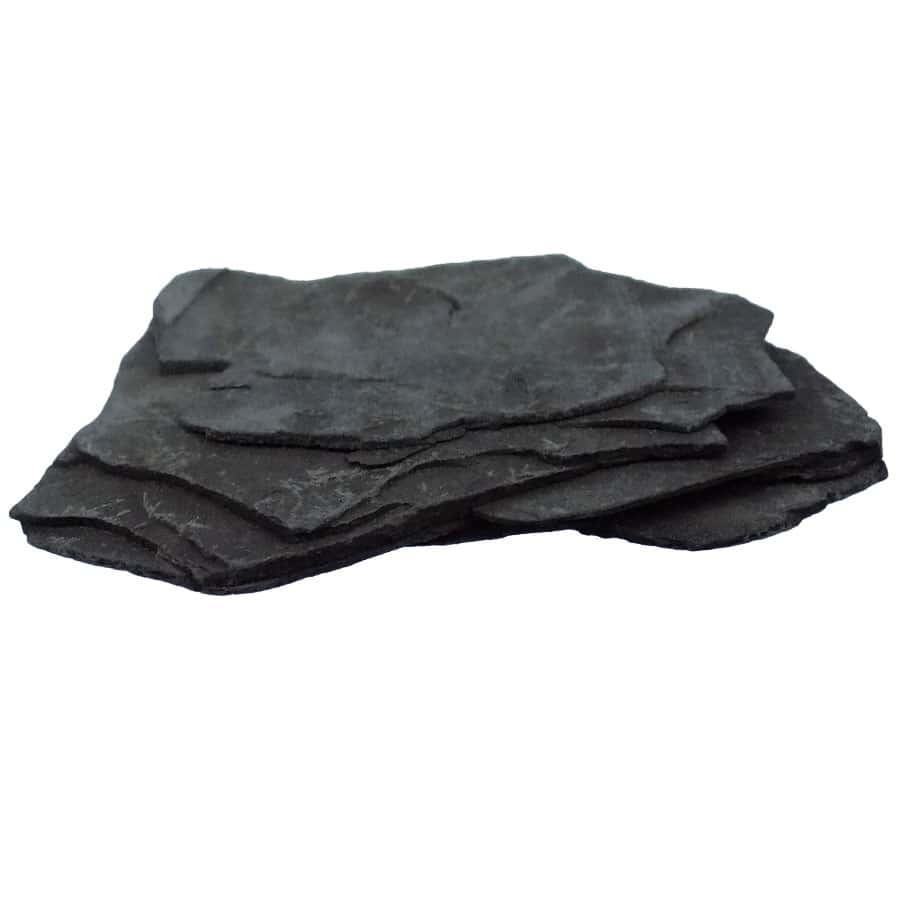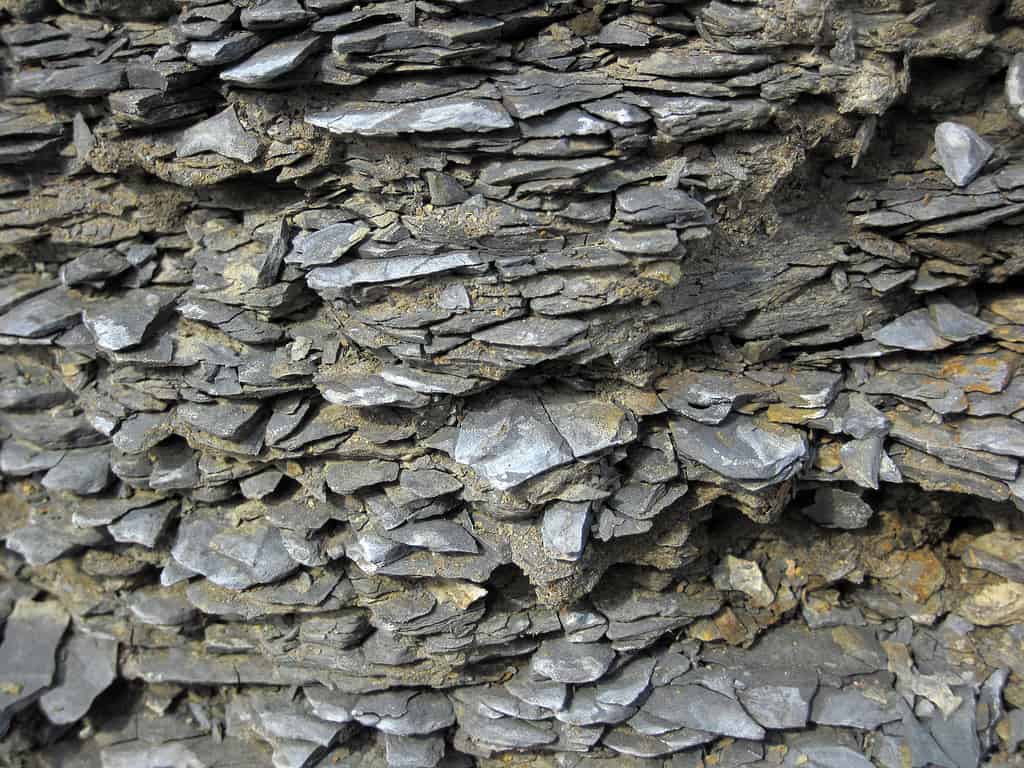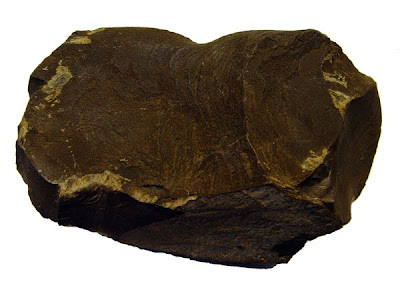Shale is significant for several reasons: it’s a common source of fossil fuels like oil and natural gas, especially through techniques like hydraulic fracturing (fracking); it acts as a geological barrier in the Earth’s crust, trapping oil or gas in other rock layers; and it’s used in the construction industry for bricks, cement, and other materials. Additionally, shale formations often provide valuable insights into Earth’s history, as they can contain fossils and are indicators of past environmental conditions.
But what is shale, and what are the geological conditions that create it? Let’s explore.
What is Shale?

Shale is a fine-grained sedimentary rock, composed mostly of clay particles and other minerals such as quartz and calcite. It is formed of many thim mineral layers and is typically characterized by its ability to break into thin layers, a property known as fissility. Shale is a remarkably common type of rock, forming a significant portion of the Earth’s sedimentary rocks.
Formation and Composition of Shale
Shale starts from the gradual accumulation of silt and clay particles in calm, slow-moving environments such as lake beds, river deltas, and deep marine settings. These fine particles, often transported by water, settle in layers, undergoing compaction and cementation over time.
Compositionally, shale primarily contains clay minerals (like kaolinite and illite), quartz, and minor amounts of feldspar, carbonate minerals, and iron oxides.
But the journey from loose sediment to rock, known as lithification, doesn’t happen immediate. It unfolds over millions of years.
Sediment Deposition
The initial phase in the formation of shale is sediment deposition. Silt and clay, carried by water or wind, settle in low-energy environments where the water is calm enough to allow these fine particles to sink to the bottom. The accumulation of these particles occurs in thin layers, a process often influenced by seasonal changes, which can lead to varying compositions in different layers.
Compaction and Cementation
As more layers accumulate, the weight of the overlying material compresses the lower layers, expelling water and reducing pore space, a process known as compaction. Alongside compaction, a parallel process called cementation occurs. Here, minerals like quartz, calcite, and iron oxides, dissolved in the water, crystallize between the sediment particles, binding them together. This gradual transformation from loose sediment to solid layered rock is essential in the formation of shale.

Organic Material and Fissility
The presence of organic material in shale is noteworthy. In oxygen-poor environments, organic matter from plants and microorganisms gets trapped within these sediments. Over time, this organic material contributes to the formation of kerogen, a precursor to oil and natural gas. The fissility of shale, its tendency to split into thin layers, is a result of the parallel alignment of the clay and silt particles during sedimentation and compaction. This feature is particularly pronounced in shales rich in clay minerals.
Variations in Composition
The composition of shale can vary significantly depending on the source of the sediments and the conditions during its formation. For instance, in areas rich in volcanic ash, shale might contain a higher amount of certain minerals like feldspar. Similarly, the presence of iron oxides or organic material can influence the color and chemical properties of the shale.
Types of Shale
Shale is not a one-size-fits-all rock; its variety is as rich as its geological history. Different types of shale can be categorized based on their mineral composition, texture, cementing materials, and the environment in which they were deposited.
Based on Texture and Composition
- Silty Shale: Predominantly composed of silt particles, this type has a slightly coarser texture than clay shale. It’s often found in environments where finer particles like clay are less dominant.
- Clay Shale: Rich in clay minerals, this type is extremely fine-grained and exhibits the classic fissility associated with shale.
- Sandy Shale (Arenaceous Shale): Contains a significant proportion of sand-sized particles, making it grittier than its purely clay or silt counterparts.
Based on Mineralogical Composition
- Quartzose Shale: High in quartz content, this type of shale is typically more resistant to weathering and erosion.
- Feldspathic Shale: Contains a noticeable amount of feldspar, often derived from the weathering of feldspar-rich rocks.
- Micaceous Shale: Characterized by a significant presence of mica, giving it a slightly shiny appearance and enhancing its fissility.
Based on Cementing Materials
- Calcareous Shale: Cemented predominantly by calcium carbonate, often identified by its reaction with dilute hydrochloric acid.
- Ferruginous Shale: Contains iron oxide as a cementing agent, imparting a reddish or brownish hue.
- Siliceous Shale: Cemented with silica, these are typically harder and more resistant to weathering.
Based on Depositional Environment
- Lacustrine Shale: Formed in lake environments, often displaying fine laminations and a variety of mineral compositions.
- Deltaic Shale: Deposited in delta regions, these may show a mix of fine and coarser sediments, reflecting the fluctuating energy of deltaic environments.
- Marine Shale: Formed in deep marine settings, these shales are often rich in organic material and may be darker in color.
Based on Organic Matter Content
- Carbonaceous Shale: High in organic carbon, often black or dark gray, indicating an anoxic depositional environment.
- Bituminous Shale: Contains significant amounts of bituminous material, making it a potential source rock for hydrocarbons.
Special Varieties of Shale

- Oil Shale: Contains large quantities of organic material (kerogen) that can yield oil and gas upon heating.
- Black Shale: Rich in organic carbon, often found in anoxic environments, and crucial as a source rock in the petroleum industry.
Characteristics of Shale
Shale is characterized by its unique set of properties that distinguish it from other sedimentary rocks. A key feature of shale is its fissility, allowing it to split into thin layers, which is a result of the parallel alignment of clay mineral flakes during its formation. The rock is fine-grained, typically smooth to the touch due to its small particle size.
The color of shale varies widely, but it is usually dark. The colors include shades of gray, black, green, red, and brown, depending on its mineral and organic content. For instance, black shale is often rich in organic material, while the presence of iron oxides can give shale a red or brown hue.
Physically, shale is generally brittle, breaking easily along its thin layers. Its hardness can vary, influenced by the degree of compaction and cementation it has undergone. Shale is also characterized by low porosity and permeability, making it relatively impermeable to fluids.
Geochemically, shales can vary in their organic content, which is crucial for hydrocarbon generation. Some shales, particularly black shales, may be enriched in trace elements like uranium, vanadium, and zinc.
How to Identify Shale
Identifying shale can be a straightforward process if you know what to look for. This guide will help you determine whether the rock in your hand is shale.
Step 1: Observe the Texture
First, closely examine the rock’s surface. Shale is very fine-grained, so you shouldn’t be able to see individual sand or silt particles with the naked eye. The surface should appear relatively smooth and homogenous.
Step 2: Check for Fissility
Try to see if the rock can be split into thin layers. Shale typically has a layered structure due to its fissility. If the rock breaks along flat, parallel planes, it’s a strong indicator that you’re holding shale.
Step 3: Feel the Rock
Run your fingers over the rock. Shale usually feels smooth due to its fine grain size. It might also feel a bit gritty but not as coarse as sandstone.
Step 4: Assess the Color
Shale comes in various colors. Commonly, it is gray, black, or brown, but it can also be green or red. The color can provide clues about its composition; for example, black shale is often rich in organic material.
Step 5: Test Its Hardness
Scratch the surface of the rock with a metal object like a coin or a key. Shale is relatively soft compared to many other rocks. If it scratches easily, it could be shale.
Step 6: Consider the Weight
Heft the rock in your hand. Shale is not particularly heavy for its size, especially when compared to denser sedimentary rocks like limestone.
Step 7: Contextual Clues
Consider where you found the rock. Shale is typically formed in environments with calm, stagnant water like lake beds, river deltas, or deep marine areas. Finding the rock in such a context can support your identification.
Uses of Shale
Shale’s versatility extends across various industries and applications, making it a resource of significant value.
In Construction and Manufacturing
Shale is a common material in construction and manufacturing. The ceramics industry heavily relies on shale for making bricks, tiles, and pottery. Its fine-grained texture and ability to be molded when wet make it ideal for such purposes. Shale also plays a critical role in cement production, where it’s combined with limestone.
As a Fossil Fuel Source
Shale is pivotal in the petroleum sector, particularly in hydraulic fracturing (fracking). This process involves injecting fluid at high pressure to fracture shale rock, releasing trapped oil and natural gas. Additionally, certain types of shale, known as oil shale, contain substantial organic matter (kerogen). Heating these shales can produce liquid hydrocarbons, similar to crude oil.
Shale formations are also significant sources of natural gas. Technological advancements in drilling and extraction have made it economically feasible to extract shale gas.
In Environmental Applications
Shale’s impermeability makes it suitable for environmental applications such as landfill covers, where it acts as a barrier to prevent groundwater contamination. It also finds use in agriculture as a soil amendment, particularly in improving drainage and aeration in clay-rich soils.
Conclusions
Shale is more than just a common sedimentary rock; it plays a pivotal role in various industries and provides critical insights into Earth’s geological past. Its widespread presence, combined with its unique properties like fissility and composition, makes shale extremely valuable. Understanding shale’s characteristics, formation, and uses not only enriches our knowledge of geology but also underscores its significance in our daily lives and the broader environment.






